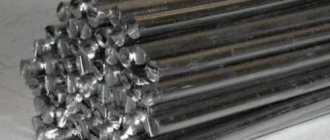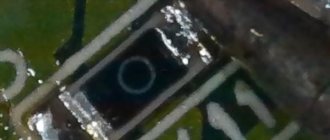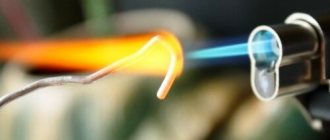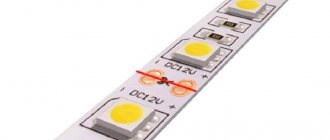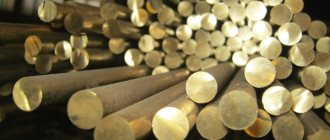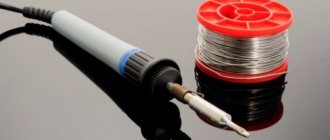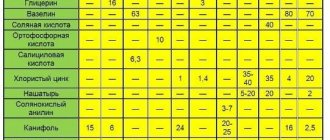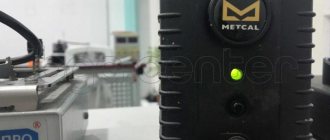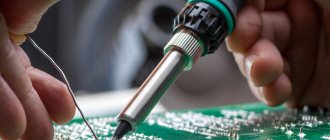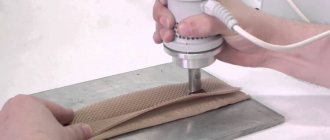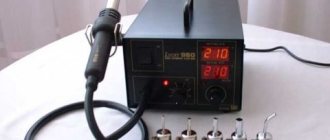About BGA chips
The use of housings with pins in the form of balls, instead of the usual pins, has now become the only alternative in micro and radio electronics.
Chip with BGA pins
Of the main advantages of using microcircuits of this configuration, we note:
- saving space on the board;
- small pickups;
- thermal conductivity, with the exception of elements of motherboards and computer video cards.
Disadvantages include: inflexibility of the leads, complexity of installation and the need for additional x-ray control after installation of these microcircuits.
What are BGA chips
Depending on the purpose and device, microcircuits come in different sizes, which in turn affects the diameter and pitch of the balls.
For example, a bridge from a computer motherboard and a processor from a smartphone differ enormously (even less are the balls from the processor to the substrate).
Also, BGA chips are often coated with a compound for cooling, protection from moisture and mechanical stress, but this makes it much more difficult to replace such a chip.
Flux requirements for bga soldering
The main task of this soldering material during the soldering process, in particular, bga elements, is the removal of metal oxides and oxide films at the stage of preparing the soldering area.
A high-quality flux should provide better spreading of solder (reduced surface tension) and prevent re-oxidation of the prepared surface.
The operating temperature of the flux must be lower than the melting temperature of the solder that makes up the terminals of the microcircuit.
In the case of using a chip with tin-lead leads, the liquidus (full melting temperature) mostly starts from 179ºC.
Soldering flux applied to the board
The flux should start working at a temperature an order of magnitude lower. So that during complete melting of the solder all oxides are removed from the soldering area.
It is worth adding to the fundamental requirements that the flux should not boil and emit carcinogenic fumes.
Easy removal of flux residues or no need for cleaning is a property that experts consider a “must have”, recently, when soldering microcircuits with ball leads.
Ideally, the flux should completely evaporate by the time the microcircuit is soldered; in extreme cases, it should be a dielectric and chemically inert in its composition.
In the case of reballing, the requirements for ease of rinsing are usually less stringent, since it is much easier to rinse off the flux using a cleaning fluid with open access to the soldering area.
Choosing a gel flux for repairing digital equipment
Every novice radio amateur is faced with the question of what equipment and what soldering materials to use? This article is devoted to soldering materials, or more precisely to fluxes-gels. Recently, many different fluxes from different manufacturers have appeared on sale, but their prices and quality can vary greatly. Moreover, expensive does not always mean good. Comparisons and video reviews most often represent monotonous material filmed on a phone with a very shallow meaning, the seller’s address and a summary “in principle, you can solder...” Let’s try to use specific examples to figure out how to distinguish a good flux from a bad one, and what to look for when making a choice. An “ideal” flux should be non-conductive and non-corrosive, non-smoking, and odorless. It must well wet the surface of the material intended for soldering, conduct heat well and evenly, and dissolve dirt and oxides on the metal surface. I also wanted it to be harmless. How “ideal” are the gel fluxes that can be found on sale? Let's try to figure it out.
Sample No. 1 is the well-known Chinese Amtech RMA223. It is a homogeneous yellowish mass in the cartridge.
First try. Dismantling the microcircuit. During soldering, it melts quickly, spreads well, and smokes moderately. It smells really strong, the smell is definitely paraffin. What is the quality of dismantling? As you can see in the photo, most of the balls are larger, others are smaller (1). Several of them resemble “heels” (2). Maybe an accident? Let's dismantle another microcircuit. Same picture.
Balls of different sizes are formed due to uneven heat distribution, to which flux has a direct relationship. The reason for the appearance of “spots” is that the Chinese sample contains very few fluxing components; it contains mainly paraffin, which neither conducts heat properly nor dissolves oxides, and evaporates easily during soldering, turning into smoke. How can you check the fluxing properties of a material? Just. We apply the sample to the foil PCB and press the soldering iron tip with a drop of tin to it. Based on the results of such “one-touch soldering” one can judge the quality of the product. In the case of testing the “Chinese”, the tin ball stuck to the surface of the copper, but easily bounced off when pressed with a fingernail.
The flux itself “runs away” from the soldering iron tip, which creates difficulties during soldering. There are flux samples that are light, almost white, yellow and brown, but they solder equally poorly.
Conclusion: Chinese flux solders no better than a paraffin candle. It's just that the latter is much cheaper. The use of such materials can lead to poor contact and equipment failure. Similar in “quality” are YAXUN RMA-223, BAKU-223, LUKEY L2010, YX RMA-223, DAINA RMA-625.
Sample No. 2, EFD FluxPlus 6-412-A , at the time of writing, cost about 1.5 thousand rubles. Is this price justified? The flux comes in a high-quality cartridge, does not smoke much when soldering, and has a pine smell. It boils slightly in the first seconds of soldering. FluxPlus contains a solvent and it boils away. As you can see in the photo, the balls on the board look the same after removing the chip.
Good results also when tinning copper. Soldering is reliable and high quality
And most importantly, he almost never “runs away” from the sting. The residue was easily washed off with alcohol, and after repair the board looked like new. EFD evaporates with very little. True, a bad nuance has been noticed: when installing and dismantling BGA microcircuits, the latter may bounce slightly due to the appearance of gas bubbles. To prevent this problem, it is worth heating the elements gradually. The overall impressions are very good, if not for one thing - the price. Conclusion: FluxPlus is a high-quality flux for repairing expensive devices.
Sample No. 3 Cyberflux E-700. According to the store seller, this is a domestic “improved analogue of EFD FluxPlus”! For 100 rubles! So what do we see? Questionable packaging, cheap, ugly sticker. And the content is interesting. A very sticky, thick, odorless substance. Smokes little. The balls are perfect after dismantling.
Soldering the board is almost instantaneous, there is no boiling, the flux does not “run away” from the soldering iron tip. Soldering quality in the photo:
BGA solders really better than EFD. Quite viscous even when heated. The latter property gave rise to the idea of using it to warm up “discarded” chips in video cards. Two video cards have been revived and have been working for almost a month. Conclusions: Price and packaging are not an indicator! Worthy for a domestic manufacturer (if it is truly a domestic manufacturer).
Sample No. 4 Mechanic MCN UV10 . The Eurocartridge with a bearded mug is supposed to symbolize that this is a gumboil for real men. Let's try! Smokiness is within normal limits. The smell is quite tolerable. It boils, but not critically. The balls after dismantling are quite decent
The piece of PCB was tinned, maybe not quickly, but decently. True, instead of a round drop it turned out to be a “carrot”, which is not very good
Conclusions: Good quality flux at a reasonable price. Products of similar quality: SUAN RMA-636, AMTECH NC-559-ASM.
Sample No. 5 . "WTO Center highly active flux-gel BGA SMD" Russia. Ryazan. Packaging eurocartridge, blister. The price is slightly cheaper than the "Mechanic". Let's try! Contents: dark brown liquid with the smell of machine oil from an overheated engine. The smoke is high. The smell when soldering is indescribable. Work only under a hood or wearing a gas mask. It's boiling hot. Nevertheless, the balls after dismantling the microcircuit are quite decent. Textolite is easily tinned
But it’s clearly better to wash off the residue, it’s too dirty. Sufficiently oxidized wires also produce hissing and smoke. It’s incomparable with the Chinese “brothers”! Conclusion: I probably wouldn’t risk “this” soldering SMD and BGA. But samovars and power cables are probably possible. It is also worth taking a gas mask in the kit.
Regarding the safety of all fluxes, it is worth remembering that in addition to the flux components, tin and lead vapors are released into the air during soldering, as well as phenol and formaldehyde contained in the board material. Therefore, it is always worth working under a hood.
In the next article, I plan to talk about how to independently identify substances that are harmful to health in fluxes and check whether the flux is actually no-clean.
Examples of fluxes intended for soldering BGA chips
How to choose a soldering flux for mounting and reballing bga chips? Below we provide examples of materials that meet most of the characteristics listed in the article. They were also tested in combat mode and proved their suitability in practice.
High quality flux for repair and soldering. Has transparent residues that do not interfere with quality control. Halogen-free. For dispensers or brush application. It is a yellowish paste with a viscosity of 6600±10% mPa.s. The declared shelf life without loss of properties is 12 months at temperatures below 10ºC.
Adhesive flux TF-A254 is indispensable for soldering and reballing BGA microcircuits in phones, laptops and other electronic digital devices, as well as when working with other SMD components. Flux TF-A254 must be washed using cleaning liquids. Vigon® is recommended. The unique technological properties of TF-A254 flux allow soldering even in conditions where the preheating was short, as a result of which the required heating level was not achieved.
We hope we were able to highlight all the most important nuances when choosing a flux when soldering BGA packages. Note that microBGA technology is currently gaining increasing popularity and demand. Where the distance between the leads is even smaller and the requirements for fluxes, as well as for other soldering materials, will be higher.
You can always get advice on selecting flux to solve your production problems by calling 8.
Do-it-yourself BGA chip replacement at home
So, the home technician has at his disposal a laptop motherboard, where during the diagnostic process a faulty surface-mount BGA chip was discovered, in particular, a chip from one of the bridges of the computer board. It is necessary to dismantle the BGA surface-mount chip, and instead of the dismantled chip, it is necessary to install another - serviceable component.
The process of replacing a faulty surface mount chip on a laptop motherboard. You will need information on removing the board from the device body.
First, the motherboard is removed from the laptop case, for which you should refer to the service instructions of the specific tablet computer manufacturer. In each individual case, the procedure for dismantling the motherboard may differ radically.
Preparing the motherboard for repair
The removed laptop circuit board is installed above the infrared quartz heater in such a way that the maximum heat flow falls on the area where the chip is being soldered.
The next step is to treat the surface-mount chip with a special flux. The dismantled chip, usually rectangular (square) in shape, is processed by uniformly applying a small amount of gel-like flux around the perimeter.
Treatment of the dismantled BGA chip with a special flux - coating the four sides of the chip body with a gel-like substance using a plastic syringe
Further according to the technological procedure:
- turn on the infrared bottom heater,
- wait for the applied flux to melt,
- at a temperature of 250-300ºC, remove the corner plastic clamps of the chip,
- After reaching a temperature of 300-325ºC, use a soldering iron.
Top heating of the microcircuit with a soldering hair dryer
A soldering gun is used to heat a surface-mounted BGA chip along the top side of the chip. If a soldering station with a temperature controller is used, the parameters are usually set to the range of 350-400ºC. Evenly directing the air flow of the hair dryer to the area of the microcircuit, wait for the tin to completely melt.
The moment of complete melting can be determined by periodically checking the condition of the chip. Once the chip begins to “wiggle” in place, it’s time to use the suction cup tool.
Using a suction cup tool, they cling to the center of the microcircuit body and simply remove the chip from its installation site. When the tin is completely melted, this operation does not cause any difficulties.
Preparing the landing area of the microcircuit on the board
After removing the faulty surface mount IC (BGA), you should prepare the installation site. Preparation consists of “cleaning” the contact pads under the tin “balls” before starting to solder BGA chips. For this procedure, it is enough to use a regular soldering iron with a tip that is well sharpened and has smooth working edges.
The procedure for stripping a surface mount chip (BGA) using a conventional soldering iron. The process takes no more than one or two minutes
The “stripping” area is first treated with a small amount of flux for BGA soldering and then the remaining tin is carefully removed with a soldering iron tip.
Radio amateurs use different methods for cleaning, including the option when using a cable braid. But the practice of an established radio amateur shows that one soldering iron, patience and accuracy are quite enough.
Installing and soldering a new serviceable component
At the next stage, the BGA chip prepared for replacement should be placed in place of the dismantled chip. In this case, it is necessary to correspond to the markers (lines) on the electronic board, including the “key” marker, which indicates the correct position of the chip according to the working contacts.
Next, the infrared quartz bottom heating heater is turned on, and the board is heated until the flux melts. Turn on the soldering gun and heat the upper area of the surface-mount microcircuit to a temperature of 350-400ºC.
That's all. A new BGA type microcircuit is installed to replace the faulty one. The laptop motherboard is ready for use. More details in the video below.
Video master class on how to solder BGA chips
A video demonstration of the process of removing a faulty chip and then installing a working BGA chip as a replacement. Repairing a laptop motherboard at home with all the details:
How to choose the right flux. Review of fluxes for soldering.
Today on the shelves of radio markets and electronics stores you can find a huge number of soldering fluxes of different purposes and prices.
Flux manufacturers offer truly high quality products, but finding them on the market is quite difficult. The number and options of fakes are simply amazing in their diversity. Even if you are lucky and find an original product, its cost will differ significantly from the cost of a fake. Most potential buyers, after comparing prices, decide to save money and look for a cheaper flux. Craftsmen select the optimal set of soldering chemicals for their requirements, which suits them in terms of technical parameters and price. But to do this, they have to sort through unknown fluxes and, through experiments, select the most suitable option for a particular job.
Hundreds of cheap fluxes with high performance parameters stated on the label are sold on almost every corner. But a completely unpleasant surprise may await you inside the package. Now let's figure out how fluxes are diluted and how this affects their technical characteristics .
Rosin instead of flux
Imagine the situation: you bought superflux, open the tube, and instead of high-quality flux there is low-quality rosin (waste from the production of rosin). Moreover, this same rosin is also very much diluted with some kind of contaminated technical petroleum jelly.
It is simply impossible to solder or tin with such a mixture. The so-called “flux” begins to “escape” from the soldering area. As a result, we get undeserved conclusions, poor-quality “cold” soldering, and contact pads and tracks instantly fall off the board due to overheating.
Dismantling of enclosures
Before you begin dismantling the old microcircuit, you should apply small marks along the edges of its body with some sharp object (a scalpel, for example). This procedure allows you to fix the location of the electronic component, which will greatly facilitate its subsequent installation.
To remove a faulty element, it is most convenient to use a thermal hair dryer, which can warm up all the legs at the same time (without the threat of damaging an already burnt chip).
In BGA dismantling mode, the heating temperature of the soldering zone should not exceed 320-350 degrees.
At the same time, the speed of the air stream is chosen to be minimal, which will prevent the melting of nearby contacts of small parts. While heating the legs, the hair dryer should be positioned strictly perpendicular to the treatment surface. In the case where there is no complete confidence in the malfunction of the part being removed, to maintain it in working condition, the jet flow should be directed not to the central zone, but to the periphery of the body part.
This precaution allows you to protect the chip crystal from overheating, to which memory chips of any computer equipment are especially sensitive.
After warming up for about a minute, you need to carefully pry the BGA chip by one of its edges with tweezers, and then slightly lift it above the circuit board. In this case, it is desirable to limit the applied force, clearly monitoring the moment of soldering of each of the contact pads.
Violation of this requirement can lead to damage to the landing spots of the microcircuit, which are part of the conductive tracks of the circuit board.
With a sudden, one-time force, a leg that is not completely sealed will certainly pull this pad along with it, and with it the entire track. As a result of such carelessness, the motherboard being restored can be permanently damaged.
Board and chip after desoldering
Flux diluted with acid
Very often, acids (citric, orthophosphoric) or chlorides (zinc chloride) are added to an already poor-quality flux. Compared to rosin, the picture immediately changes - everything is tinned and soldered. It seems that the flux is simply superb, but electronic boards cannot be soldered with such flux. It is very difficult, and sometimes almost impossible, to remove acid residues, especially from under SMD elements. Acid can even remain inside the solder, in the pores of the solder.
As a result, after a month or two, soldering with acid (or zinc chloride) crumbles into powder along with the terminals of the radio element. Repairs will then be very, very labor-intensive, and sometimes they will be completely impossible.
Flux diluted with glycerin
It also happens that glycerin is generously poured into the flux. Glycerin flux solders great, it's cheap and there's plenty of it, but try coating a board with it. And then measure the resistance of the PCB board. That's bad luck: it conducts current from units to tens of Ohms where it should not conduct. Even if you try to wash off the glycerin, and it washes off easily, the “conductivity” of the board will still remain! Glycerin is absorbed into the PCB (the resistance of PCB not coated with copper is from 10 to 50 Ohms ). For most devices this is simply not acceptable. Even the simplest and most banal schemes will fail. To somehow make the device work, try scratching the textolite between the tracks with a needle.
Conclusion: glycerin, acids, chlorides in no-clean fluxes for working with radio electronics, BGA and SMD components should not be used.
Basic requirements for high-quality flux for working with lead elements, BGA and SMD:
- lack of corrosive activity
- good tin properties
- high wetting ability
- no boiling when heated to operating temperature
- lack of electrical conductivity
- ease of removal of residues if necessary
- support for lead-free and lead-containing solders
- no-clean soldering technology (residues do not need to be washed off)
- ease of application (gel, paste)
- affordable price.
Characteristics of fluxes and their features
Let's now look at some of them in more detail. First, let's look at the name. What do all these big letters mean?
- G (gel) - gel-like flux.
- NC (no clean) - does not require rinsing.
- 5268 – flux index.
- LF (lead free) - suitable for lead-free solders.
CHIPSOLDER G-NC-5268-LF
This flux is suitable for soldering tinned contacts. It has good thermal conductivity; the contact pad remains on the board and not on the soldering iron tip. Gel flux CHIPSOLDER G-NC-5268 LF is a high-quality, translucent, synthetic no-clean flux with resin-like characteristics. Used for soldering and disassembling BGA/SMD components. Suitable for working with a soldering iron, hot air gun, IR station, as well as for reballing.
The flux is made from highly purified components. Conveniently secures BGA and SMD components during soldering (“fitting”). Fully supports both conventional and lead-free soldering technology. Halogen-free for long-term reliability and excellent soldering performance.
It has minimal, “soft” activity when soldering, which allows you not to wash off residues. It does not boil, does not leave a dark “carbon deposit”, and remains a transparent gel after soldering. It loses transparency only at a temperature of -5 °C, but at the same time retains its properties. Easily removed using any alcohol-based (gasoline-based) universal product and a paper napkin.
It has excellent thermal conductivity (the component heats up as evenly as possible) and is very convenient to use. Does not contain solvents, does not dry out in the open air and does not harden after soldering. Suitable for repeated use.
CHIPSOLDER –G-NC-6500-LF
This flux is very similar to G-NC-5268-LF, but is designed primarily for lead-free solders. Although it also solders well with conventional (lead-containing) solders.
After soldering it remains transparent and hard (the residue is slightly harder than in flux 5268).
Can be used for re-soldering. It is not necessary to rinse off, but if it is necessary to rinse off, use any universal alcohol (gasoline) based product.
CHIPSOLDER –G-NC-6800-LF
The flux is intended primarily for “difficult” rations. It has the same adhesive gel consistency as G-NC-5268-LF, but has increased tinting ability. It removes oxidation well from the soldering site and is intended for both conventional soldering and soldering (tinning) of highly oxidized leads and contacts. It has high thermal conductivity, the component heats up as evenly as possible. It does not boil, does not leave a dark “carbon deposit”, remains a transparent gel after soldering, is easily wiped off with a paper napkin and is very convenient to use. Does not contain solvents, does not dry out in the open air and does not harden after soldering. Suitable for repeated use.
The flux residue is clean, soft, transparent, non-corrosive and non-conductive. Cleaning the residue is not necessary, but if necessary, it can be wiped off with a dry cloth or any alcohol-based (gasoline-based) product.
This flux is convenient for restoring “cold” solders, soldering after water ingress, as well as “fallen off” BGA contacts. Often, with the help of this flux, it is possible to tin even those contacts that more expensive fluxes cannot do.
BGA balls or BGA paste
| Jovy Systems JV-PB60 | Jovy Systems JV-LFSB050 |
| Jovy Systems JV-PB40 | BGA balls 0.6 mm |
As noted above, BGA balls or BGA paste can be used as reballing solder. In this case, the pin recovery algorithm is significantly different.
Technologically, the use of BGA paste significantly simplifies the process, but quality suffers as a result. The contact surfaces during such reballing are non-uniform and can differ significantly in size. Therefore, this method is most relevant for repairing mobile phones where the chip size is small.
In the case of motherboard reballing, BGA balls are usually used.
Both BGA balls and BGA paste can be leaded or lead-free. The use of lead-free consumables is justified only in an authorized service center.
Fluxes SP
These fluxes are similar in characteristics to the CHIPSOLDER series of fluxes, but they are a little cheaper. It should be noted that the cost did not affect the quality. They can also work great and get good results. Now let's look at each of them in more detail.
So, let's start with SP-10+ flux
This is a cheap and pretty good low-activity flux. It is recommended to be used for mounting and dismantling FLIP CHIP, BGA and SMD components, crystals, as well as for repair work using a soldering iron, hot air gun, and IR equipment.
Has virtually zero activity. Used for soldering and dismantling tinned leads. Suitable for lead-free solders. SP-10+ is absolutely safe for radio components. Evenly distributes temperature during soldering and prevents peeling of printed conductors. It has an adhesive consistency (viscous, sticky), does not cause corrosion, and reliably fixes elements when soldering. It also does not conduct current.
The flux is used without subsequent cleaning in printed circuit assemblies. Suitable for use in various environmental conditions.
The SP-15+ will be next on our list. This is a universal flux. Has average activity (“soft” activity). In terms of its characteristics and scope of application, the SP-15+ is virtually no different from the SP-10+. The main difference between them is activity: SP-15+ is medium active, and SP-10+ is low active . It is recommended to use it for warming up and mounting BGA dumps, as well as for mounting and dismantling FLIP CHIP, BGA and SMD components.
SP-18+ is no longer just a flux, but a medium-active flux paste .
It is recommended to be used for low-temperature soldering. Designed for soldering with solders with a melting temperature from 80 to 180 °C . Not suitable for lead-free solders. Evenly distributes temperature during soldering and prevents peeling of printed conductors.
There is a small amount of residue after using SP-18+, but it can be easily washed off if necessary. This flux paste has a slightly yellowish color, is non-corrosive and safe for radio components.
SP-20 is already an active flux paste .
Recommended for most types of work. It has increased activity, tins well without acidic effects.
SP-20 , like SP-10+, SP-15+, SP-18+, is used for mounting and dismantling FLIP CHIP, BGA and SMD components, crystals, as well as for repair work using a soldering iron, hot air gun, IR equipment . Suitable for lead-free solders.
Can be used for soldering and tinning of oxidized leads and contact pads. Also suitable for warming up and installing BGA dumps. Flux is used for various printed circuit assemblies with high-frequency circuits.
After working with SP-20 there is a small amount of residue that can be easily washed off if necessary. This flux paste does not conduct electric current, is safe for radio components and reliably fixes elements during soldering.
The main difference is consistency. SP-30 is a translucent, adhesive gel. The flux is intended for repair and production of electronics. Can be used with all standard solders.
Features of work
In order for BHA soldering to turn out to be of high quality, you need to worry about purchasing a good stencil or mask, when choosing which it is recommended to observe the following conditions:
- the presence of special thermal gaps in the mask (thermal profile);
- small stencil sizes and easy-to-apply structure;
- It is desirable that laser technology be used in the manufacture of the stencil.
A feature of Chinese-made products is the inconvenience of working with multilayer chips, when applied to them and then heated, the mask begins to sag. If the size of the stencil itself is significant, it begins to absorb heat, which can also affect the efficiency of BGA soldering. To eliminate this effect, it will be necessary to increase the heating time of the contacts, but at the same time the risk of thermal damage to the product increases. All of the above applies only to stencils obtained by chemical etching.
That is why, when choosing a mask, you should proceed from the possibility of purchasing a sample with thermal seams prepared using laser cutting technology. Products of this class guarantee high precision in the orientation of contact pads (with a deviation of no more than 5 micrometers).
When considering the features of soldering chip packages, one cannot help but touch upon such an important concept for this process as reballing. In professional practice, this refers to the procedure for restoring the contact pads of electronic BGA components using microscopic solder balls.
Which flux is best for bga soldering?
Hello, I would like to hear a professional opinion on some aspects of soldering.
1. What is the best flux to use (not very expensive) for soldering connectors, small things, etc.? (Now I’m soldering some kind of F5, but it’s not very good).
2. What flux should I use for soldering BHA? Now I'm soldering RMA-223 (most likely a fake).
3. When you plant a BGA microcircuit, do you need to coat the contacts and board with flux?
4.What is the best way to wash the board after fluxes?
Thank you in advance .
1 . , any flux you like..(I sometimes solder connectors with active flux for soldering aluminum..but then rinsing in water is necessary)
2. I myself have been using FluxPlus EFD for 4 years PN: 7019074
3. Before planting the bga... I apply flux only to the board
4. Flux-off perfectly removes flux residues from the board (without cleaning). (I also often use gasoline galoshes.. and isopropyl alcohol)
after soldering the board with active fluxes...it is advisable to rinse it in a high-pressure cleaner...at least in water..
Does it matter what flux you use? Try a few and decide for yourself which one is better. Flux Plus, which everyone praises so much, for me personally is simply unbearable with its smell. I use Chinese in a round jar, whatever it’s called, who knows, but the smell is normal and there are no problems with soldering. I use it everywhere, I don’t see any point in washing the board after it - I cleaned the galoshes and that’s it. If you use it in moderation, no one will ever notice that someone was soldering until it starts to heat up. But it’s not like you disassemble the phone after the “masters” and there the entire board is covered in flux, so you can’t even see the markings on the M/S, but you can’t even see the key
this is if “masters use soldering oil... Chinese... which they buy” the distinctive feature of such a flux... when heated... it begins to smell like machine oil... or some other sh-t... but that means you bought a fake fluxplus... because the original has practically no smell. ) and it costs from 400 rubles per tube of syringe..and for “meisters..this is a scribe, what money...”
this is if “masters use soldering oil... Chinese... which they buy” the distinctive feature of such a flux... when heated... it begins to smell like machine oil... or some other sh-t... but that means you bought a fake fluxplus... because the original has practically no smell. ) and it costs from 400 rubles per tube of syringe..and for “meisters..this is a scribe, what money...”
Who the hell knows. I took it from the locals (250 rubles), the guys gave it to me (they say they bought it from gsmserver, which by the way the sticker says on the syringe) the smell is the same. I do not like him.
Nope! Fluxplus orig. It smells specifically (for me - pleasant) when heated, I can distinguish it from thousands of other fluxes or odors. Smells like pine resin concentrate or something similar: classic:
Whoa. That's exactly what it smells like. If there is no hood it is impossible to breathe:lol:
Hello, I would like to hear a professional opinion on some aspects of soldering.
1. What is the best flux to use (not very expensive) for soldering connectors, small things, etc.? (Now I’m soldering some kind of F5, but it’s not very good).
2. What flux should I use for soldering BHA? Now I'm soldering RMA-223 (most likely a fake).
3. When you plant a BGA microcircuit, do you need to coat the contacts and board with flux?
4.What is the best way to wash the board after fluxes?
Thank you in advance .
1. For soldering connectors, it is better to use pine rosin, preferably obtained independently from a Christmas tree in the forest, a natural product. You won't run into a fake. 2. For soldering the bga, I use the same rosin, crushed in a coffee grinder (or twisted in a meat grinder) and mixed with windshield washer fluid, the liquid is cheaper - it is stronger. 3. You can plant the bga dry, spit a little onto the soldering area. 4. Oddly enough, the board is best washed by a solution of cow's milk with water and Klin beer.
Good luck with the repairs.
1. For soldering connectors, it is better to use pine rosin, preferably obtained independently from a Christmas tree in the forest, a natural product. You won't run into a fake. 2. For soldering the bga, I use the same rosin, crushed in a coffee grinder and mixed with windshield washer fluid, the liquid is cheaper - it is stronger. 3. You can plant the bga dry, spit a little onto the soldering area. 4. Oddly enough, the board is best washed by a solution of cow's milk with water and Klin beer.
Good luck with the repairs.
You burn:lol: did you remember to pour gasoline on it and then set it on fire? To dry better?:lol:
Thank you all very much for the advice, in general, can the connectors be soldered with RMA 223? What liquids can you use? Which cleaning spray is best to use to clean boards from oxides and flux?
And another question: why is this paste used? https://ua.all.biz/img/ua/catalog/1008010.jpeg
Somehow I’m not keen on expensive fluxes and pastes. Kanesh understands that this is professionalism and sometimes saves time, but I use paste for 25 UAH and a jar of gumboil for 15. Everything works out great.
ZY Before planting the BGA, I don’t give a lot of paste, because the mikruha rides on it. When she’s already hooked, then I give it from the heart and give it a good drink and push...
Z.Y. Before planting the BGA, I don’t give a lot of paste, because the mikruha rides on it. When it’s already hooked, then I give it from the heart and solder it well and push it.. And so that it’s soldered well, use more paste under the bga:laugh: . We are talking specifically about paste, right, not about gumboil?
Which cleaning spray is best to use to clean boards from oxides and flux? It will be 2 different sprays, or even 3 or 4.:wink:
BGA soldering of a processor using the example of a tablet
The tablet booted every other time. When pressure is applied to the processor, the loading screen goes through, but the charging percentage is 0%. Changing the battery and trying to flash the device did not lead to anything. Engineer mode is also not available.
There is a lot of loose debris near the processor; it is better to cover it with thick aluminum tape so as not to accidentally blow it away.
Processor desoldering
Be sure to take a photo of the soldering area so that there are no problems determining which side the key is located. First, the soldering area is heated to 100 - 150 °C at maximum air flow. After about a minute, gradually increase the temperature. 200 °C, 250 °C and ceiling 310 °C - 320 °C. At temperatures above 250, we try to gently rock the processor with tweezers. If it stands still, then wait some more (or increase the temperature, but not more than 320 °C). When the processor wobbles from one touch of tweezers, then it’s time to remove it. In this case, everything is protected with foil, so the risk of touching the crumbs is minimal, so you can use tweezers to fold it onto the board.
Removing the solder
It is better not to use braid to avoid damaging the mask. Using a soldering iron and a little solder on the tip (to dilute the solder with what is on the board), we move along the pads with light and not sudden movements. Naturally, before this we apply flux to the board. The same procedure applies to the processor itself. It is important not to overheat it and not rip off the coin.
By the way, after desoldering it was discovered that on several contacts there was a detachment of the processor from the board. Since the copper layer was intact on the processor, we were able to re-tin the broken contacts with the balls.
CPU reballing
Reballing is the resoldering of a microcircuit. This is not replacing the old one with a new one; in fact, the balls on the chip are updated for better contact with the board.
Using solder paste and a stencil, we apply new balls to the processor.
Soldering temperature is much lower. 180 °C - 200 °C. We fix the processor to the stencil using the same aluminum tape.
After the stencil, clean the processor and apply a little flux. Then we heat it again so that the balls fall into place more accurately and melt better. Clean after this procedure.
Then, before installation, apply flux to the board in an even layer. Using spatulas or toothpicks, distribute it evenly so that all contacts are well soldered and the processor does not float.
We place the processor according to the key and position its edges. Since there is a lot of tape around, this won’t be too difficult. After this, we also first heat the board at 100 - 150 °C, then increase it to 200 °C - 230 °C and carefully try to touch it with tweezers to make sure whether the solder has melted or not. If you do this abruptly, you will have to repeat everything again because... the balls stick together.
After soldering, remove the tape and it is best not to clean the board at all. There is very little air under the BGA chips, and therefore, once the cleaning agent gets there, it is very difficult to completely remove it. Of course, you can try to “evaporate” the flux at 100 °C, but if you have a good and no-clean flux, then there is no need to worry.
The tablet started to turn on without any pressure on the processor, but after booting it turned off at 0%. Only now can you enter engineer mode and try to reset the tablet. After the reset, the device turned on normally and shows the charging process, the remainder and stopped turning off.
Now you need to carefully check all its functions. Camera, sound, microphone, Wi-Fi, touchscreen.
Choosing a flux for soldering
First you need to understand what flux is. Flux is a substance that allows hot liquid solder to wet solder joints. After the solder cools, a solder joint forms. If you do this without flux, you will end up with a cold solder joint that may fall off immediately or over time. All fluxes exhibit acidic properties when hot. Many are acids at ordinary temperatures, for example, orthophosphoric acid, soldering acid. The higher the acidic properties during soldering, the stronger the flux, the better and faster the soldering will be. Here is a list of fluxes we produce in order of increasing activity. The higher the number, the higher the activity of the flux.
- Rosin
- Liquid rosin
- Flux paste
- Liquid rosin LUX
- rosin gel
- rosin gel active
- LTI-120
- Glycerin hydrazine flux
- FIM
- F-34
- Soldering acid
- Orthophosphoric acid
- F-64
Does this mean that you can take the strongest flux and solder everything? Unfortunately no. For example, the strongest flux we produce is F-64 - a flux for aluminum and it has the appropriate chemistry for this. But for soldering copper, “Orthophosphoric acid” will be the strongest. But otherwise, if you don’t have enough flux activity, you need to look at this list and take the more active one, next by number. A safety list of residues will also help you avoid choosing too active a flux:
- Soldering acid
- Orthophosphoric acid
- F-64
- F-34
- FIM
- Glycerin hydrazine flux
- LTI-120
- Liquid rosin LUX
- Rosin gel Active
- Rosin gel
- Liquid rosin
- Flux paste
- Rosin
Choosing a flux for soldering
Soldering small radio components onto a printed circuit board.
If all the parts are tinned, then Liquid rosin or LTI-120 will suit you. There is no need to remove residues, but ensure they dry as liquid residues can have mega-ohms. Liquid rosin can be replaced by flux paste; due to its paste-like form and non-drying base, it has some advantages. Residues are harmless but difficult to remove. A modern means of replacing liquid rosin and flux paste is Rosin gel. Having all the advantages of both fluxes, it, consisting of modified rosin, is as easily removed as Liquid rosin, and at the same time has a higher activity. A gel-like replacement for LTI-120 is Rosin gel Active. In structure it is a rosin gel and in activity it is comparable to LTI-120. Rosin is used quite rarely today for soldering radio components. Steels are widely used LTI-120LUX and Liquid rosin LUX due to their fashionable property of absolute water washability. For soured radio components, it is better to use LTI-120 or Rosin gel active, as well as the new fluxes LTI-120LUX and Liquid Rosin LUX.
Soldering small radio components onto a printed circuit board.
Rosin activated fluxes: LTI-120 or Rosin gel active cope excellently with large-sized radio components. Glycerin hydrazine flux has also proven itself very well, but after it it is necessary to clean the soldering areas with hot water from glycerin residues. Residues of Glycerin hydrazine flux do not oxidize soldering and for parts not related to electronics, residues are acceptable, but residual mega-ohm resistances are possible on the printed circuit board.
Iron, copper, brass. Small parts.
When the parts are small and you don’t have to resort to acid fluxes, use Glycerin hydrazine flux or LTI-120. Water-containing LTI-120LUX and Liquid Rosin LUX can also cope with this task. Flux paste often helps. Sometimes what is more important is not the activity of the flux, but how long it takes for it not to evaporate at the soldering temperature, since the part still needs to be heated and during this time the active, but quickly evaporating flux will evaporate. This is where water-based fluxes, such as LTI-120LUX and Liquid Rosin LUX, Hydrazine Glycerin, come in handy. In addition, non-drying fluxes Rosin gel Active and flux paste can be very useful for the same reason as water ones. Unlike water-based fluxes, they do not hiss and melt beautifully.
Iron copper brass, galvanized iron. Massive details.
In such cases, take acid fluxes: Soldering acid, Fim, Phosphoric acid. Acidic fluxes begin to work instantly and it seems that the part needs to be heated less. This is an illusion, but it reflects how much easier parts can be soldered when using acid fluxes. Orthophosphoric acid and soldering acid are more or less similar in activity. FIM flux has less activity. They differ in their residues after soldering, and for such active acid fluxes this is very important. The residues of orthophosphoric acid begin to interact with metals first. These are dark gray deposits of phosphates. But these residues are quite stable and create a strong phosphate film that protects the metal from oxidation. Suffice it to say that this acid is used in auto repair shops instead of galvanizing, which is unreliable in garage conditions. Phosphate coatings obtained in this way reliably protect iron from rust. Cl of soldering acid takes a little longer to manifest itself. The residues are metal chlorides that form unsightly oxides. If it is iron used outdoors, then it can become a catalyst for rust. And finally FIM flux. Its remains, due to the low content of orthophosphoric acid, are slightly corrosive, so it is well suited for clean but active rations. A question that very often arises among people who solder with active fluxes: What to do when you are soldering a product and the last seam closes the container? Some of the flux will remain inside and it will no longer be possible to remove it. The answer to this question was found in Soviet times when sealed casings of infrared instruments for satellites were sealed. The last seam was made exclusively with orthophosphoric acid. The quantity was selected exactly as needed for soldering. The flux was applied with a pointed wooden stick soaked in acid. The sufficiency of flux was determined by how much flux was sprayed. Control autopsies were carried out after climatic tests. On the inside of the soldering joint, where removal could not be carried out due to inaccessibility, flux residues formed persistent phosphate films that did not affect anything.
From everything I said, it’s clear that the residues need to be removed. And if in the case of orthophosphoric acid it is necessary to remove residues for aesthetic reasons, then in the case of soldering acid this will prevent further troubles. How to remove acid residues? Ideally rinse off with plenty of water with a brush. It is better to use Flux Remover after this, which neutralizes the acidity of acid flux residues. Wiping with a damp cloth is also widely used. Usually two or three movements are enough. But you need to wipe it, not like you brush crumbs off a table, but with a little effort so that the soldering shines. It is better to remove rosin fluxes using a “rosin solvent”, but you can use most solvents sold in household goods or alcohol.
Soldering aluminum.
There are many “ways” to solder aluminum. For example, rub a soldering iron tip under some kind of rosin flux and maybe the solder will stick to the aluminum in some place. All this is more like making fire with tinder. Today everyone uses lighters. And for soldering aluminum there is a modern flux F-64, which easily solders aluminum just like rosin flux solders a printed circuit board. But don’t get carried away - when soldering a lot, turn on the ventilation. F-34 flux was made using a completely different chemistry. It is much less active, but also many times safer. Both are fluxes whose residues require removal.
vote
Article rating
Rolling balls
When rolling balls, you must use a clean and even stencil (especially when soldering with paste).
An example of a bent and dirty stencil. It is not suitable for knurling.
If you use a bent and uneven stencil when rolling balls with solder paste, all the solder will stick together under the stencil. It's useless.
The microcircuit itself is cleaned of old balls, but not at the root, to make it easier to install it on the stencil. The stencil must be installed evenly so that all contact pads can be seen through the stencil, without distortion.
Soldering a small BGA eMMC chip
Clean the microcircuit with isopropanol. Its contacts should be smooth. If there is solder, remove it with a soldering iron. During soldering, the microcircuit and stencil should only be placed on napkins or wooden boards. A metal surface will absorb heat, but a wooden, paper or air surface will not.
How to attach the microcircuit to the stencil
There are several options. The first is thermal tape. It attaches quickly, does not leave behind a lot of glue and does not shield high temperatures. Among the disadvantages is that it peels off quickly and is not securely attached in comparison with aluminum thermal tape.
Aluminum tape is securely attached to the board, but leaves behind a lot of glue and shields the temperature.
On the one hand, aluminum fastens better, on the other hand, it’s faster and more practical to use regular thermal tape. Start learning with aluminum, try different options.
Applying paste
Apply the paste with a regular toothpick or spatula. You can use cotton swabs, but they absorb a lot of paste.
Large lumps of solder should not remain on the surface of the stencil, otherwise they will stick together and will have to be soldered off.
Holding the stencil
If during heating the stencil begins to bend and you cannot apply balls, then you need to hold it with tweezers.
You don't need to press too hard, just a little pressure. We first heat the stencil to 100 °C, then increase it to the melting temperature of the paste. Typically this is between 200 and 260 °C. The balls should form gradually. If you quickly increase the temperature, the flux in the solder paste will begin to boil and the solder will jump out of the stencil. We'll have to start all over again
Glass and touchscreen
You can also use glass or a touchscreen to hold the stencil.
If temperature changes and pressure are high, the glass may crack and burst. Be careful and attentive, use safety glasses.
How to remove a microcircuit from a stencil
Do not abruptly remove the microcircuit from the stencil, bend it or pick it out. You can bend the stencil or tear off the BGA contacts. If you can't remove the chip, look at the side of the holes. The solder on the front side should not stick to the stencil. Try cleaning the stencil with the microcircuit with isopropanol or gasoline with a Galosh brush several times.
Next, heat the chip to 120 °C for 30 seconds. The microcircuit can be removed with tweezers and only slightly straightening the stencil, without sudden movements.
Example video
The video uses a different microcircuit and soldering without tweezers.
Rolling balls on the south bridge
On this chip, you first need to restore the contacts.
Restoring contacts
Apply solder paste in a thin layer and start heating with a hairdryer from 100 °C, gradually increasing to 200 °C.
And the solder paste begins to narrow the contacts with micro balls. Why not a soldering iron and regular solder? They are worse suited for such work. The hair dryer heats the contacts evenly, and the micro balls do not immediately stick together into a large lump of solder. And we remove the rest of the solder with a soldering iron.
One of the sections has been restored.
This way we go through all the contacts. After restoration and removal of excess solder, clean the contacts with isopropanol and cotton wool.
Another way to attach
The microcircuit is large, so the stencil is single. There is a special fastener for single stencils. This is a carriage with two clamps and a spring. Attached with a hexagon.
We fix the microcircuit in the fastener and align it according to the stencil pitch.
Applying paste and soldering
Apply solder paste evenly over the entire area.
There should be enough paste on the contacts of the microcircuit, without shortage and without too much.
Using circular movements, first heat the stencil to 100 °C. Smoothly increase the temperature and slowly heat one edge to 200 - 250 °C. Gradually the paste will begin to turn into solder.
Clean the stencil with isopropanol to dilute the flux. We heat the stencil again to 100 °C for 20 seconds.
Using a blade, carefully pry up the stencil without sudden movements from all sides and it will come unstuck from the south bridge (microcircuit).
We clean the microcircuit from unnecessary balls and flux. Now all that remains is to trim the balls. Apply flux in drops over the entire area.
We heat the chip and the balls begin to distribute evenly in their places. After this, we clean the chip from flux again.
We attach the stencil to the microcircuit and check the quality and presence of balls.
Soldering result.
A little about bottom heating
Next, the chip is soldered to the board. Such massive BGA parts are difficult to solder to the board using only a hair dryer. Masters in service centers use bottom heating. It helps to warm up the board. Infrared soldering stations are commonly used for soldering motherboards.
Despite the fact that mobile BGA microcircuits can only be soldered with a hairdryer, to reduce the risk of poor soldering or tearing off contacts, craftsmen also use bottom heating. It is smaller than for motherboards, but no less efficient.
Ready-made balls and application method
It differs from paste in the method of application. Apply flux to the chip. It is needed to glue the chip and stencil together during soldering. And then put a stencil with a glued microcircuit into the container and pour balls of the desired diameter. Use a toothpick to distribute the balls and remove any excess.
Soldering is similar to paste.
